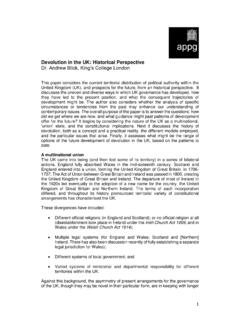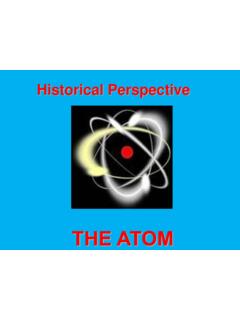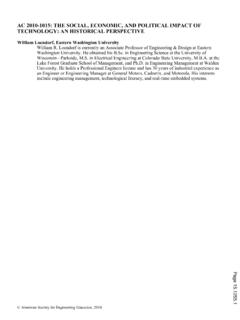Transcription of Community Colleges in America: A Historical Perspective
1 Community Colleges in America: A Historical Perspective by Richard L. Drury from Inquiry, Volume 8, Number 1, Spring 2003 Copyright 2003 Virginia Community College System Abstract Drury traces the development of Community Colleges in America from their earliest days through modern times. Historical Development Community Colleges in America, originally termed junior Colleges or two-year Colleges , have their roots dating back to the Morrill Act of 1862 (the Land Grant Act), which essentially expanded access into public higher education. This expansion allowed for the inclusion in Colleges and universities a vast majority of individuals who had been denied access to or precluded from higher education for various reasons. The second Morrill Act (1890) provided for the withholding of federal funds to those Colleges that withheld student admission to land grant Colleges based on race unless the states provided for separate institutions for minorities.
2 This Act again allowed for the expansion of minorities being admitted into land grant Colleges . However, it was not until 1901 that the first junior college in America was founded. William Rainey Harper, president of the University of Chicago, was the major force behind its creation. Several leading university presidents, including Harper, began at this time to recognize that the first two years of college are not necessarily a part of university-level education. In fact, the president of the University of Missouri stated in 1896 that during the freshman and sophomore years of college, not only are students identical, but the character of the teaching is the same (Brint, 1989). Harper, two years later, emphasized this same point in a speech to the National Education Association. In short, there was a movement that would focus universities on research rather than teaching, especially at the upper-division level and graduate schools.
3 This movement caused many universities to purge the freshman and sophomore levels and avoid general education. In short, a university based on this paradigm would be an elitist model, the thinking behind it being greatly influenced by the German University or the pure-form university, which avoids having to deal with students who may be less intellectually able or prepared than their peers. Along this model, a rationale was developed that the first two years of postsecondary education should be an Page 1 of 6 Community Colleges in America: A Historical of the high school. This was the way German high schools were organized. In essence, the high school proposed by these early proponents would be a six-year institution. In 1892, Harper divided the University of Chicago into a "junior college" and a "senior college," thereby creating an organizational separation. He went further by introducing the associate's degree for graduates of the junior division.
4 The design of this degreed program was to eliminate all but the truly gifted for entry into the senior division, relegating the lower division to junior Colleges (Cohen, 1996). Harper's efforts at trying to get local high schools to offer college-level courses were not that successful until, in 1901, a friend and colleague of Harper's, J. Stanley Brown, principal of Joliet High School, introduced college-level courses into his high-school curriculum. The result was the establishment of the first independent public Junior College in America. Growth of junior Colleges was quite slow during the early years of the twentieth century. By 1910, there were only three public junior Colleges ; by 1914 there were 14 public junior Colleges and 32 private junior Colleges . From 1907 to 1917, California passed various legislation authorizing California secondary schools to offer postsecondary courses and providing funding for independent regions for junior Colleges .
5 These districts had their own boards, budgets, and policies. But again it was the elitist motive from California's university administrators that influenced this legislation. Several social forces contributed to the development of the Community college. Cohen (1996) states that the most prominent forces behind this movement were the need for workers to be trained to operate the nation's expanding industries, the lengthened period of American adolescence, and the national drive towards social equality. Society perceived schooling as a means of upward mobility and contributing to society. More schooling was thought to be beneficial to society as a whole. Additionally, there were other social, political, and economic factors that influenced the development of the two-year Colleges in first part of the twentieth century. As mentioned, the elitist movement by university administrators greatly influenced the two-year college development. The fostering of social and cultural mobility for farm families, shopkeepers' children, and other workers influenced growth beyond the early movements in California, New York, and Illinois.
6 There was also a sense of Community pride in building these Colleges and a sense of belonging and cultural development of the local citizens. There was a strong sentiment by Community residents that college education should be available to all. Religion played a significant role. More than half of all junior Colleges from 1900 to 1916 were affiliated in one Page 2 of 6 Community Colleges in America: A Historical or another with church denominations. Populist political motives also played significant roles by fostering the local cultural enhancement capability of the local Community . Although some Colleges offered vocational courses in these early days, most offered liberal arts courses that could be transferred to universities. College prep was the main focus, with little attention given to occupational training in these early years. In 1920, the American Association of Junior Colleges (AAJC) was founded, at a critical time in the evolution of junior Colleges .
7 Today, this organization is the American Association of Community Colleges and is the national organization for Community Colleges in America. The early years brought wide differences between those members favoring transfer programs and those promoting vocational training. Yet the biggest problems facing junior Colleges in the early 1920s were those of image recognition, lack of respect from senior Colleges and universities, and reconciliation of vision among members. The early leaders of the AAJC, Leonard Koos and Walter Eells, were perhaps the most strategic-thinking leaders of the time. Both developed successful strategies to sell the concepts of terminal vocational education to academically oriented junior-college administrators, faculty, and students. These strategies included the promotion of intelligence testing and guidance counseling as a means of channeling students into vocational training programs, or as Koos labeled it "semi-professional training.
8 " Koos also was among the first to promote the use of standardized aptitude tests as a means of tracking students into vocational training. Of course, this vocational training is terminal education whereby students would essentially terminate their studies upon completion of the two-year program. Alexis Lange, Dean of the School of Education at the University of California, stated during this time that the junior college could not make preparation for the university its excuse for being (Brint, 1989). The founding of the Associations' Junior College Journal in 1930 provided a crucial forum for promoting vocational curricula (Brint, 1989). Eells was the first editor of the journal, which made it easier for the inclusion of vocational training materials. Junior college development was given greater impetus in 1932 by a report prepared by the Carnegie Foundation. The report studied higher education in California with the purpose of determining the desirability of transforming two-year Colleges and teachers' Colleges into four-year institutions.
9 The conclusions drawn from the report focused on the differing functions of institutions of higher education; the state university (California) had an effective monopoly on research and training for the higher professions; the state Colleges concentrated on preparing graduates for mid-professions, such as teaching; and the junior Colleges focused on training for the general education of the masses, semi- professions, and vocational training (Brint, 1989). This report provided legitimacy to the junior college. Page 3 of 6 Community Colleges in America: A Historical Great Depression marked a great boom in junior college enrollment. This was caused primarily by young adults unable to find work coupled with significant increases in high school graduates. From 1929 to 1939, enrollment jumped from 56,000 to 150,000 (Brint, 1989). With college education perceived since the 1920s as the avenue for social and economic upward mobility, social attitudes, too, played a major role in expansion of the junior Colleges .
10 During this same time period, the AAJC membership was forming a consensus relative to curriculum. The concept of a two-track curriculum was gaining momentum; transfer and terminal tracks would be established. However, there still were a great many views on the real purpose of the Community college. Another significant debate concerned the proper organizational place for junior Colleges . Are they part of higher education or part of secondary education? In the end, the proponents for alignment with higher education won. Walter Eells favored a 6-3-3-2 grade level plan in which the junior college would be considered part of higher education. This ignited further debate during the 1930s and was quite offensive to those advocates seeing the junior college as a capstone to secondary education. Eells' proposed link to higher education finally won out, based on the argument that if the junior college was to succeed in the American cultural and political context, then it needed to be linked to higher education.


















